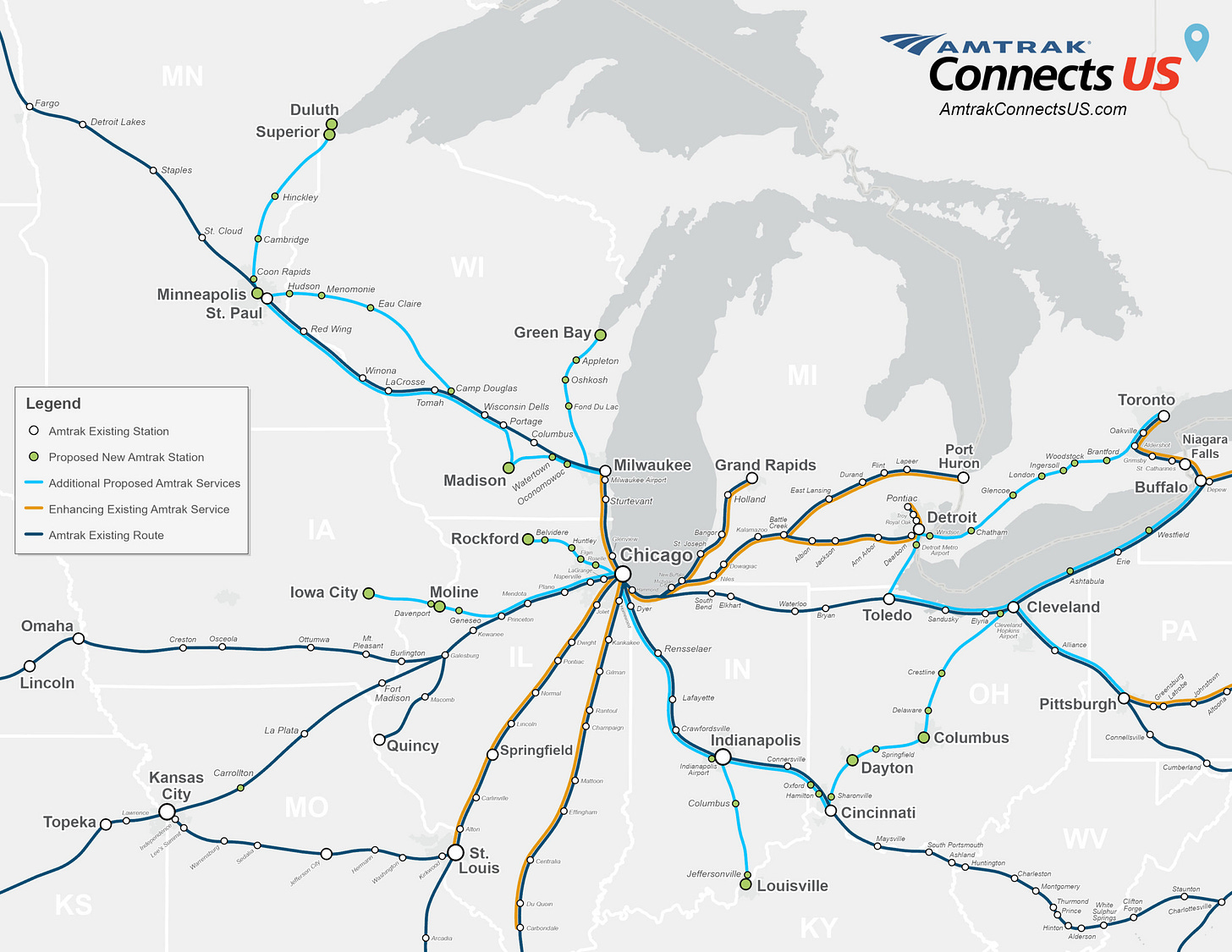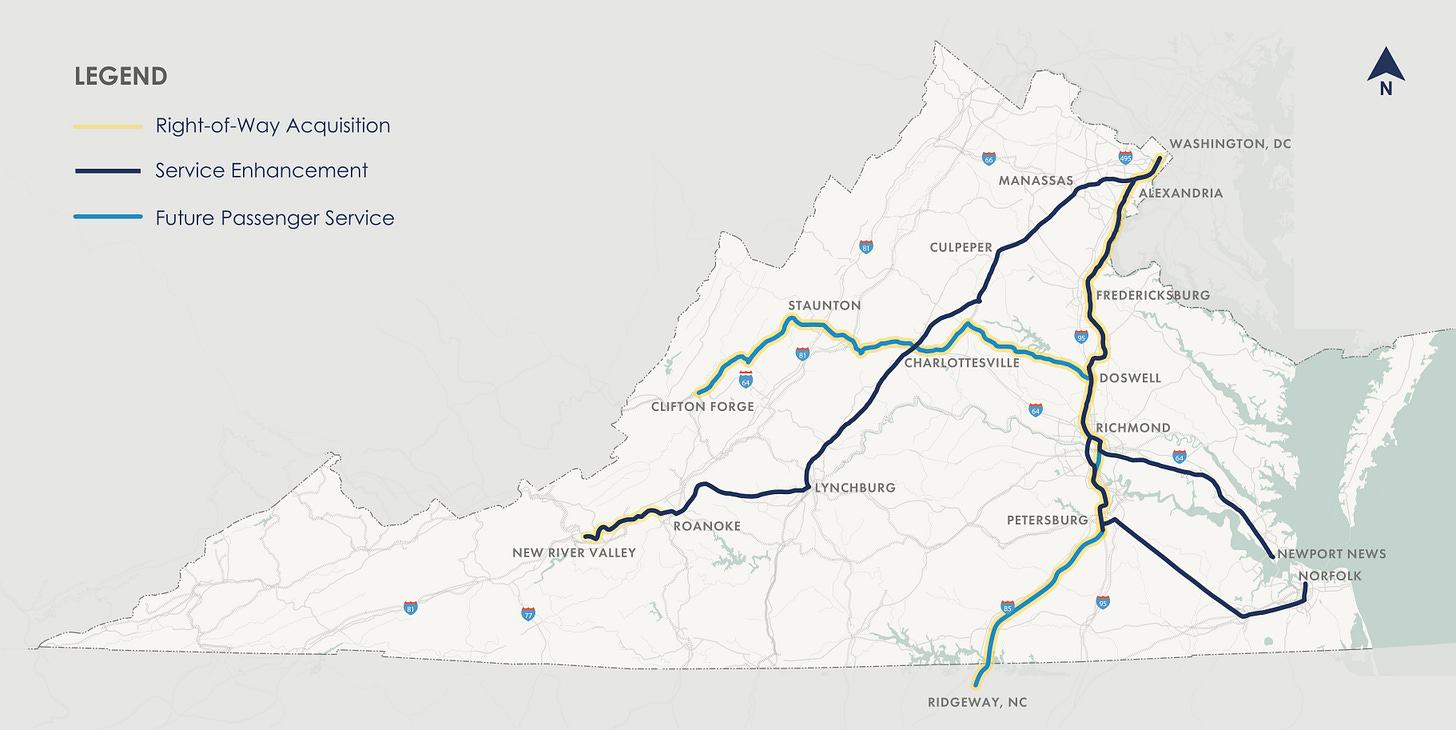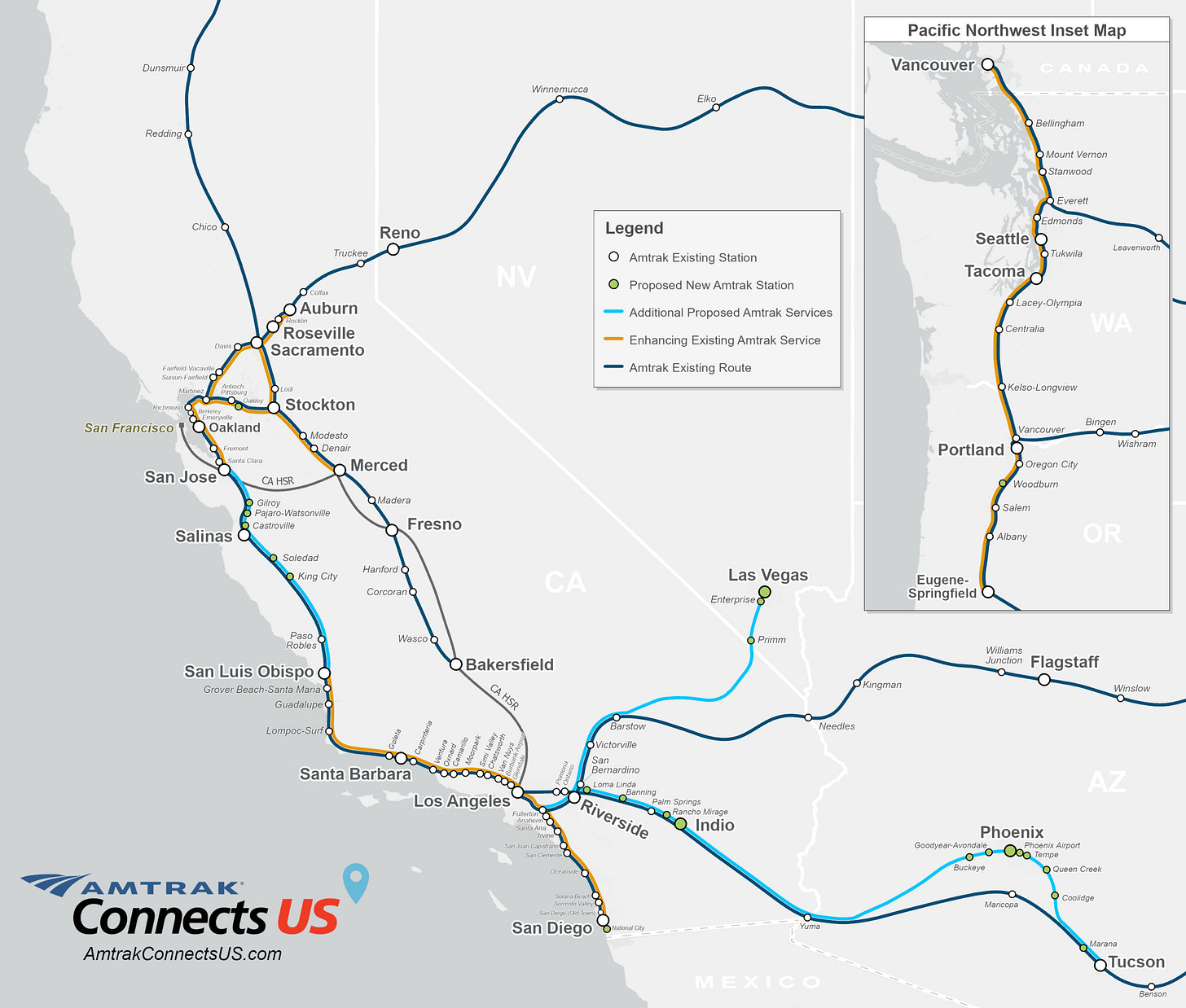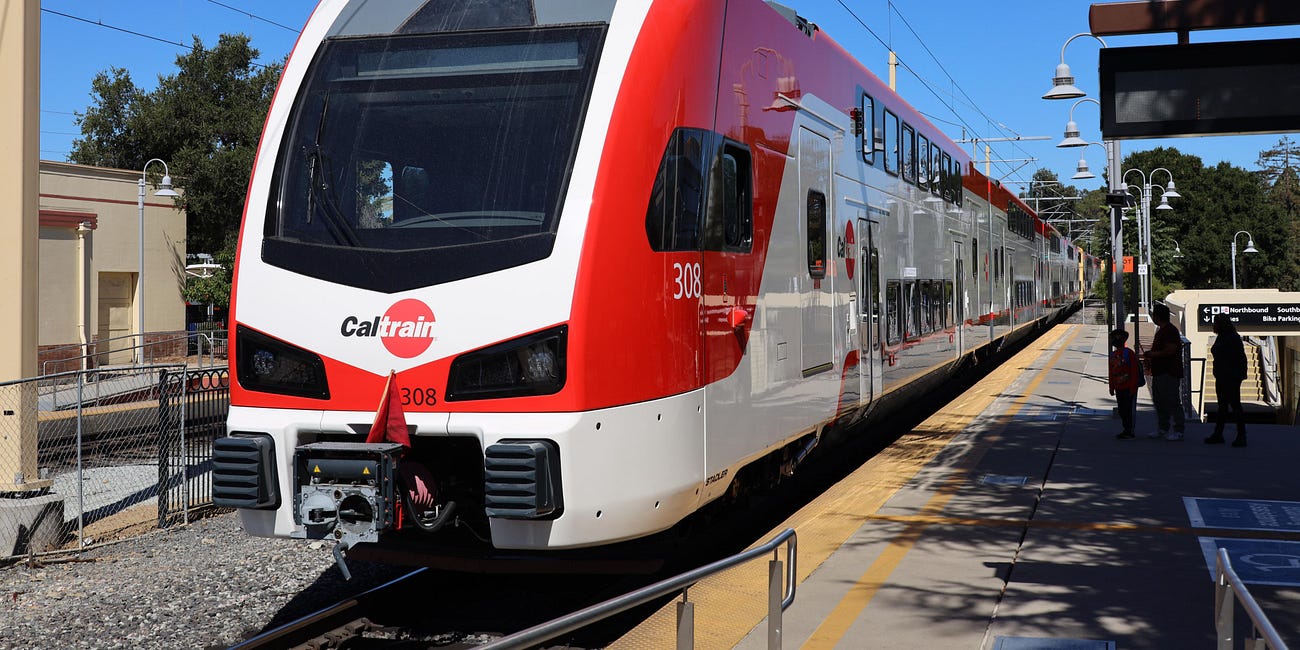America's Unsung Rail Renaissance
High-speed rail is a ways off, but vastly improved conventional rail is right around the corner. Let us count the ways.

You can hear them as they plug in their devices at their seat. You can hear them as they pass through the hissing automatic doors between cars. You can hear them as they enter the spacious, sparkling restrooms.
“Wow.” “Nice.” “Is this a new train?”
To which I reply to my fellow passengers, “Yes. Yes, it is.”
Siemens Venture cabs started rolling onto Amtrak Midwest routes in 2022, and by now they’re a ubiquitous sight in this corner of the Amtrak system. These are the same cab cars used by the privately-owned Brightline system in Florida, and are considered the top-of-the-line for passenger rail in North America. Northeast Corridor riders won’t be able to experience the new train smell until 2026, since the Airo trains slated for those routes keep getting delayed.
For once, the future came early to the Midwest. Riding in these new train cars, as I did on four journeys this month, the excitement around the revival of passenger rail is palpable. State-of-the-art rolling stock is the most vivid sign that train travel is no nostalgia trip. It’s modern, it’s efficient, it’s comfortable, and it’s only getting better.
Better is the operative word here. The Infrastructure Bill’s $66 billion investment in trains, combined with improvements that were already in the works, will not yield revolutionary changes to passenger rail. But over the next few years, these investments will lead to faster, more frequent, more comfortable and more widespread service across the country. On several rail-friendly corridors — big city pairs less than 300 miles apart — train travel will go from an eccentric travel option to a perfectly logical one.
That vision of the not-so-distant future starts to crystallize as you survey major inter-city passenger rail improvements underway, or with a feasible path to fruition. These improvements to conventional passenger rail — as opposed to 150mph or above high-speed rail — don’t get a lot of attention in the media. But they will cumulatively impact the lives of many more Americans, much sooner, than multi-generational infrastructure projects like California High-Speed Rail.
Here are some of the biggest projects to watch:1
Illinois and Amtrak are cobbling together federal grants to renovate Chicago Union Station, the beating heart of America’s passenger rail system. This complex slate of projects would improve operations and the passenger experience at the station. But more importantly, these projects would lay the groundwork for dramatic increases in passenger rail service across the Midwest, creating the potential for through-running trains connecting, say, Indianapolis and Milwaukee via Chicago. Today, all intercity trains that enter Chicago terminate there, meaning passengers must transfer trains to travel to other destinations. Additionally, Illinois recently upgraded much of the line connecting Chicago and St. Louis for 110mph train service, shaving 30 minutes off of the trip.
Minnesota is expanding service between St. Paul and Chicago by 2026, and is studying much more significant upgrades that would dramatically increase speed and frequency on the corridor. This would also lead to enhanced service through Wisconsin. With a Democratic trifecta in the statehouse, the Minnesota state legislature this year appropriated funds to begin developing the Northern Lights Express, a new route connecting the Twin Cities and Duluth.
Michigan is in the unique position of owning long stretches of track. It has taken advantage of this by upgrading a 45 mile section of the Detroit-Chicago Wolverine corridor to 110mph speeds, and has an even longer 110mph segment under development. The state also owns a long north-south rail line from Ann Arbor to Traverse City that is being studied for rail service. Another corridor under study would link Detroit, Lansing, and Grand Rapids.
Virginia is America’s great unsung passenger rail hero. In 2021, the state took the unprecedented step of purchasing over 300 miles of track from a freight rail operator, including most of the track on which its existing passenger trains currently travel. The state is currently working to upgrade key sections track for higher-speeds and more service. A new bridge across the Potomac will enable two times more service between Washington, DC and Richmond, with trains as frequent as every hour.
North Carolina, along with Virginia, has secured a federal grant to begin a new direct rail service connecting Raleigh to Richmond and the Northeast Corridor beyond. This line would connect to the recently upgraded state-owned Piedmont Corridor, which links Raleigh to Durham, Greensboro and Charlotte.
Florida is beginning planning work on new tracks that could eventually connect Brightline’s recently-opened Orlando Airport station to Tampa. This complex project would be a partnership between SunRail, Central Florida’s commuter rail operator, and Brightline, offering transfers between the two systems and creating new stations at or near major theme parks like Universal Studios and DisneyWorld. From there, Brightline could be extended along Interstate-4 to Tampa, at which point the privately-owned railroad would serve Florida’s three largest metro areas.
Massachusetts just won a federal grant to upgrade track connecting Boston and Springfield in Western Mass. The project will enable trains to travel 80 miles per hour, and will make the train trip between the two cities competitive with driving. It also lays the groundwork for much more frequent trips going east/west across the state.
New York State has several ongoing improvement projects on its Empire Corridor linking New York City, Albany, Rochester and Buffalo. In February, the state released an environmental impact report for a comprehensive slate of upgrades that would reduce travel times from NYC to Albany to under two hours. The plan also envisions a doubling of service between NYC and Buffalo.
Pennsylvania just authorized a plan to upgrade tracks in order to add another daily round trip between Pittsburgh and New York City via Harrisburg and Philadelphia. A new service between Scranton and NYC is also under development.
California is always talking about improving passenger rail. Tons of projects are in planning —including a new route from LA to the Coachella Valley — though it’s unclear which will move forward, when. The most significant near term improvements could include increased service on the popular Los Angeles-San Diego route. The Altamont Corridor Express train connecting San Jose and the East Bay to the Central Valley is currently getting extended to Merced, where it will provide a transfer to the initial segment of California High-Speed rail. And the Capitol Corridor service just won a federal grant to increase service from Sacramento to its northern suburbs.
Washington State days ago released a service vision for the Cascades route, envisioning as many as 16 trains per day connecting Seattle and Portland, as well as increased service to Vancouver, Canada, and Eugene, Oregon. The plan would require major infrastructure upgrades on the largely freight-owned right of way, which would eventually result in significant speed improvements.
Colorado is quickly moving ahead with planning on the Front Range line, which would link all of the state’s major population centers, including Pueblo, Colorado Springs, Denver, Boulder and Fort Collins, as well as nearby Cheyenne, Wyoming. Colorado Governor Jared Polis has championed this project, and could put forth a ballot measure seeking funding as soon as next year.
The Magic of Electrified Trains
A remarkable technology is about to make transportation in Silicon Valley much faster, much more convenient, and much more environmentally friendly. I’m speaking, of course, about electrified trains. Unlike electric cars, autonomous cars or highway expansions
In a future post, I’ll lay out the high-speed rail projects currently under development. But it’s just as important to take stock of these more workaday projects, which are quickly, quietly making rail a viable transportation option for millions of Americans.
My train journey across the Midwest was a reminder that if you get the basics right, people will ride.
Trains were sold out on two of my four trips, and on all four the mood was jubilant. Around a third of the passengers on my Saturday morning River Runner train from St. Louis to Kansas City were headed to Octoberfest in Hermann, Missouri. Judging by the number of White Claws consumed onboard, I was grateful they weren’t driving.
My Thursday morning ride on the Wolverine, which links Detroit and Ann Arbor to Chicago, felt a lot like the Northeast Corridor. It’s a business-y route with lots of people working on laptops, linking two big cities with innumerable economic and social ties.
My only complaint about these trips? Frequency. Train travel on these corridors is enjoyable and convenient, but it’s frustrating that there are so few train times to choose from. The Wolverine has three round trips per day, and the River Runner has two. Needless to say, such a pitiful level of train service connecting major cities would be unthinkable in any other country.
I was mercifully spared from major delays, but this is another issue Amtrak needs to address. When I told people I was on a train trip across the Midwest, delays were the first thing a couple of people mentioned.
Infrequent trains and all-too-frequent delays are both connected to the fact that Amtrak does not own most of the track it runs on. Federal laws giving Amtrak priority over freight trains are often ignored by freight rail operators, and enforcement is rare. That will have to change if Amtrak is to fulfill its aspirations. It’s also why, in the meantime, some of the most promising corridors are mostly state-owned, like Richmond-Washington, DC, and Detroit-Chicago. The Northeast Corridor and Brightline are both owned by the passenger rail company that operates there (Amtrak and Fortress Investment Group, respectively), which is why these two lines can offer hourly or better service.
Despite these hurdles, I’m optimistic about the future of passenger rail in America.
Amtrak officials believe they’ll hit pre-pandemic ridership levels in 2024, but, as an Amtrak power user, I’m willing to bet they’ll come close this year. In addition to all of the ongoing and in-progress upgrades enumerated above, passenger rail is well-positioned to benefit from long term trends.
Remote work and passenger rail are a match made in heaven. It’s much easier to have a productive workday on a five-hour train ride than on a one-hour flight. Even as big city commuter rail systems suffer, medium-distance Amtrak routes could benefit from hybrid super-commuters coming into the office just one or two days per week.
The renewed focus on downtown revitalization could be another factor in Amtrak’s favor, as city boosters look to rail as a means of injecting trainloads of people into the heart of the city. And as climate change becomes an increasingly prominent issue, the environmental benefits of trains — especially compared to aviation — will loom large.
We just might be in the early days of a major shift, in which government and citizens are beginning to see passenger rail as a serious mode of transportation once again. Take a ride and find out.
Many of these projects were highlighted by X user @ThunderWolf08 in an informative thread. The High-Speed Rail Alliance is another helpful resource for information on passenger rail development.







high speed rail will be in California too by 2030, it will be smaller then it should be but once it gets started service in the valley, I bet other politicians will be clamoring and will pay for the full line